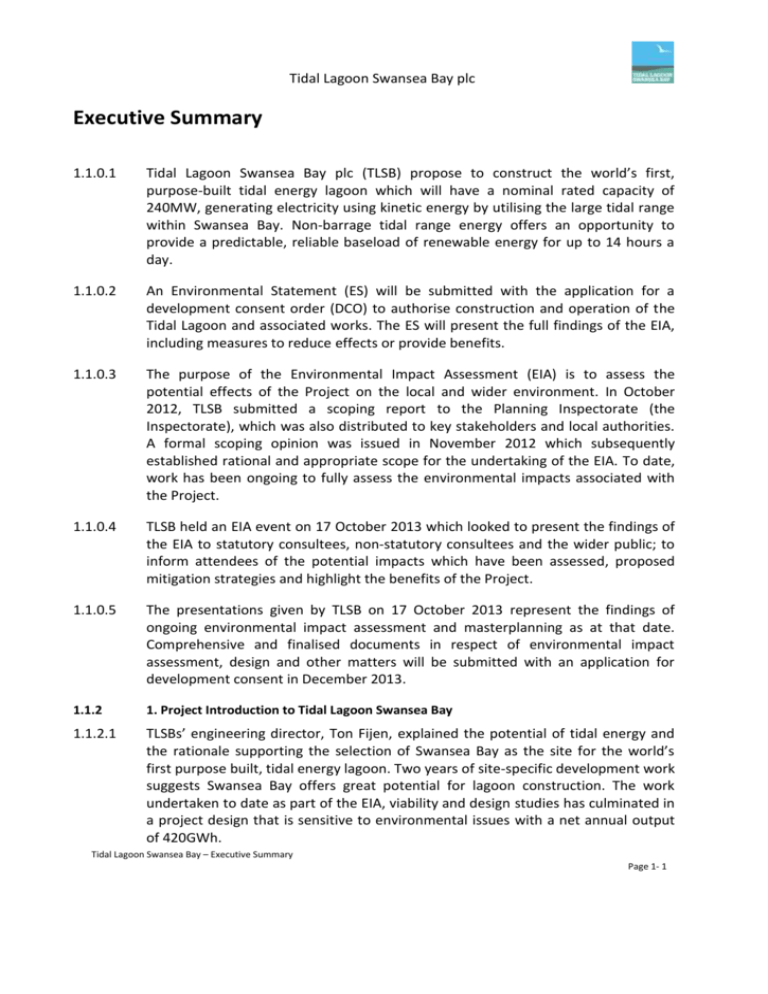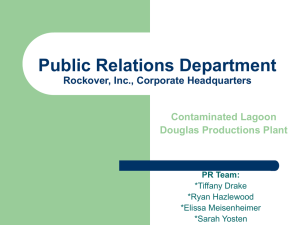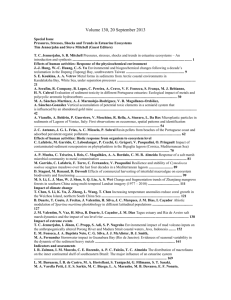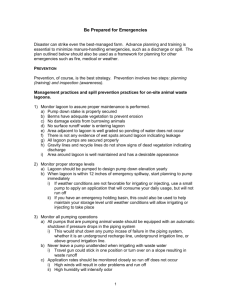Executive Summary
advertisement

Tidal Lagoon Swansea Bay plc Executive Summary 1.1.0.1 Tidal Lagoon Swansea Bay plc (TLSB) propose to construct the world’s first, purpose-built tidal energy lagoon which will have a nominal rated capacity of 240MW, generating electricity using kinetic energy by utilising the large tidal range within Swansea Bay. Non-barrage tidal range energy offers an opportunity to provide a predictable, reliable baseload of renewable energy for up to 14 hours a day. 1.1.0.2 An Environmental Statement (ES) will be submitted with the application for a development consent order (DCO) to authorise construction and operation of the Tidal Lagoon and associated works. The ES will present the full findings of the EIA, including measures to reduce effects or provide benefits. 1.1.0.3 The purpose of the Environmental Impact Assessment (EIA) is to assess the potential effects of the Project on the local and wider environment. In October 2012, TLSB submitted a scoping report to the Planning Inspectorate (the Inspectorate), which was also distributed to key stakeholders and local authorities. A formal scoping opinion was issued in November 2012 which subsequently established rational and appropriate scope for the undertaking of the EIA. To date, work has been ongoing to fully assess the environmental impacts associated with the Project. 1.1.0.4 TLSB held an EIA event on 17 October 2013 which looked to present the findings of the EIA to statutory consultees, non-statutory consultees and the wider public; to inform attendees of the potential impacts which have been assessed, proposed mitigation strategies and highlight the benefits of the Project. 1.1.0.5 The presentations given by TLSB on 17 October 2013 represent the findings of ongoing environmental impact assessment and masterplanning as at that date. Comprehensive and finalised documents in respect of environmental impact assessment, design and other matters will be submitted with an application for development consent in December 2013. 1.1.2 1. Project Introduction to Tidal Lagoon Swansea Bay 1.1.2.1 TLSBs’ engineering director, Ton Fijen, explained the potential of tidal energy and the rationale supporting the selection of Swansea Bay as the site for the world’s first purpose built, tidal energy lagoon. Two years of site-specific development work suggests Swansea Bay offers great potential for lagoon construction. The work undertaken to date as part of the EIA, viability and design studies has culminated in a project design that is sensitive to environmental issues with a net annual output of 420GWh. Tidal Lagoon Swansea Bay – Executive Summary Page 1- 1 Tidal Lagoon Swansea Bay plc 1.1.3 2. Access, masterplanning and landscape 1.1.3.1 Alister Kratt, partner at LDA Design, provided an overview of the key themes and design principles which have been incorporated into the access and masterplanning for the lagoon and supporting works. The key themes identified were: to generate sustainable energy using natural processes, to enliven sport, tourism and leisure within the Bay, to provide a dynamic educational environment and to provide new habitats and establish a new coastal landscape. The lagoon will create a world class public realm and coastal experience which has been shaped through consultation and continual design refinement. 1.1.4 3. Coastal Processes 1.1.3.1 Adam Fulford, senior consultant at ABPmer, presented the findings of the coastal processes assessment targeted at investigating the potential effects on the physical environment including: hydrodynamics, waves, sediment transport, morphology, construction plume assessment and potentially associated sediment contamination. The aforementioned was assessed for both near and far-field regions and each stage of the project. The results indicated that no significant changes to sediment transport pathways were observed fronting Kenfig sands. However, the eastern arm of the lagoon will likely act to block some of the anti-clockwise circulation, resulting in an accretion of the sediment in the area fronting Crymlyn Burrows. With respect to flows these align to the lagoon walls along Neath and Swansea approach channels and result in little overall change in potential sedimentation. Within the western part of the Bay, reductions in mean flows speeds are likely to counteract some of the predicted increase in wave height (due to reflection). In terms of sediment quality, the results of the site investigation showed that contaminant (including metals and organic pollutants) in the sediments at surface and at depth had some concentrations above Cefas Action Level 1, but none above Cefas Action Level 2 (which is generally considered unsuitable for sea disposal). 1.1.5 4. Marine Water Quality Assessment 1.1.5.1 Nick Barcock, director at Intertek, provided an overview of the main water quality drivers within Swansea Bay coastal waters defined under the Water Framework Directive. Designated waters within the Bay include Shellfish Waters and Bathing Waters. Water quality has been assessed under the various designations and directives relevant to the Bay, in particular: microbial impacts on designated waters, general water quality, dissolved oxygen and potential effects of metals released from sediment during construction. In summary, water quality impacts of the lagoon on Swansea Bay are low. The presence of the lagoon will tend to increase local advection and dispersion between the lagoon and the Swansea and Afan Coastlines; generally having a positive impact on water quality in Swansea Bay as a whole, but in particular at the bathing waters. In terms of water quality in the lagoon, at present three mitigation options are being considered to address the Tidal Lagoon Swansea Bay – Executive Summary Page 1- 2 Tidal Lagoon Swansea Bay plc occasional storm water discharge from the Swansea Waste Water Treatment Works. Each option is capable of delivering improved water quality within the lagoon. 1.1.6 4. Navigation and marine transport assessment 1.1.6.1 Tom Westwood, from Anatec Ltd, presented the results of the shipping and navigation assessment which focused on various aspects such as: navigational features, anchorage areas, aids to navigation, AIS vessel tracks, daily number of vessels and maritime incidents. In addition, consultation with stakeholders has played a key role informing the assessment, including the ‘Hazard Workshop’ held in April 2013 attended by maritime stakeholders. A number of potential impacts have been identified during the project phases including vessel allision, changes in transit routes for recreational and fishing vessels and an impact on the pilot boarding station. Mitigation is being considered to reduce any impacts including permanent additional aids to navigation, relocation of the pilot boarding station, operational procedures and planning, promulgation of information, wall design etc. Additional mitigation measures will be developed to best reduce the residual risk, to an acceptable level. 1.1.7 5. Fish (including recreational and commercial fisheries) 1.1.7.1 Richard Horsefield, of Turnpenny Horsefield Associates, explained the findings of the fisheries assessment. Baseline studies were informed through multiple sources: literature reviews, correspondence with stakeholders, review of Marine Management Organisation landing figures, Cefas fisheries data, Marine Biological Association’s archive for Marine Species and Habitats Data, National Resource Wales data and targeted quarterly multi-method fish surveys. The ecological impact assessment, performed on eight key species, included a comprehensive review of the baseline fishery and development of bespoke fish behaviour models to assess migratory pathways and encounter rates within the lagoons/turbines. Principal areas of concern identified were: waterborne noise, impact to the migratory pathways of fish and injury to fish from passage through turbines. The worst case (no allowance for avoidance behaviour) annual percentage of impact (mean mortality) on populations was less than 1% for most species and less than 3% for three further species. The greatest mean mortality (26%) was observed for Herring; however significant reduction of this figure may be achieved through proposed mitigation – construction works occurring after the Herring spawning period, and appropriate spawning media to be provided after year one of construction for use for the September spawning run. 1.1.8 6. Marine Ecology Tidal Lagoon Swansea Bay – Executive Summary Page 1- 3 Tidal Lagoon Swansea Bay plc 1.1.8.1 Elena San Martin, from ABPmer, presented the results of the marine ecology assessment. Key ecological receptors assessed were; plankton, macroalgae, intertidal ecology and subtidal ecology. Protected habitats and species noted from the assessment are: Sabellaria alveolata, hydroid rockpools, piddocks, mudflats, sands and gravels and the native oyster. ABPmer conducted surveys across the bay in 2013 to establish the baseline intertidal conditions – noting changes in habitat distribution and extent compared to past Countryside Council for Wales intensive survey work. The results indicate the dynamic nature of the environment in the Bay. The potential impacts identified for the habitat extent (e.g. loss of habitat under lagoon footprint) were assessed to be insignificant to moderately adverse, which would be reduced to insignificant to minor adverse through proposed mitigation strategies. 1.1.8.2 Key receptors for the marine mammal assessment were the harbour porpoise and grey seal. Some of the potential impacts identified during the construction and operating phase were: collision risk with vessels or turbines, visual disturbance, noise/vibration disturbance and barrier to movement. Through application of proposed mitigation strategies, impacts from noise disturbance, turbine collision risk and barrier to movement are reduced to insignificant to minor adverse. An ongoing monitoring programme will be established as part of the Project. 1.1.9 7. Terrestrial Ecology 1.1.9.1 Matt Pickard, MP Ecology, explained the results of the terrestrial ecology assessment, which was supported by the following baseline surveys: phase 1 habitat survey, phase 2 National Vegetation Classification survey, breeding birds, reptile, otter, bat, invertebrate and strandline invertebrate surveys. The assessment was further informed through consultation with statutory consultees, local experts, Swansea University and desk studies. Within Swansea Bay there are a number of statutory designated sites, which are identified as key ecological receptors, e.g. Crymlyn Bog Special Area for Conservation, Crymlyn Burrows Site of Special Scientific Interest (SSSI) and Blackpill (SSSI). Potential construction impacts identified are: habitat loss or modification, killing, injury or disturbance of protected or otherwise notable species and pollution events. Mitigation, including timing of works and standard good construction practices will minimise potential effects during construction. Measures such as creation of a salt marsh habitat, new grassland areas and dune habitat are proposed to reduce ecological impact and provide enhancement. 1.1.10 8. Coastal Birds Tidal Lagoon Swansea Bay – Executive Summary Page 1- 4 Tidal Lagoon Swansea Bay plc 1.1.10.1 1.1.10.2 David Rees, from Soltys Brewster Consulting Ltd, explained the findings of the assessment undertaken to measure the potential impacts upon the Coastal Bird assemblage that utilise Swansea Bay, including Blackpill SSSI. The assessment was informed by a review of existing literature and targeted bird surveys noting species of importance such as: Oystercatcher, Redshank, Knot, Pintail, Common Scoter, Sanderling and Ringed Plover. Designated areas include Burry Inlet Special Protection Area (SPA), Carmarthen Bay (SPA), Crymlyn Burrows (SSSI) and Blackpill (SSSI). Field surveys confirmed the use of the Bay by a similar assemblage of birds species to those recorded in the long term data sets (GOS and WeBS). In terms of potential impacts and mitigation, disturbance to roosts during the construction phase would be minimised by constructing outside of the main overwintering period. Impacts on foraging activity are likely to be insignificant due to availability of alternative foraging areas nearby. Potential benefits may be created through inclusion of Kittiwake roosts on the turbine house, the potential provision of BioReef habitat in intertidal areas to enhance local biodiversity and feeding habitat as well as creation of saltmarsh habitat. 1.1.11 9. Other Environmental Impact Assessment Chapters 1.1.11.1 Specialist consultants presented the EIA findings for the remaining chapters which will be included in the ES. a) Seascape & landscape visual assessment (Soltys Brewster Consulting Ltd.) – Visually verified photomontages for 12 viewpoints were displayed at the event. b) Air quality (URS Infrastructure and Environment Ltd.) – Potential impacts from road traffic exhaust emissions and from dust generation were considered. Road traffic exhaust emissions were assessed using the Atmospheric Dispersion Modelling System while a qualitative assessment was undertaken for dust generation. The project is not located within an Air Quality Management Area. There will be no significant effects on pollutant concentrations at nearby residential receptors or at Crymlyn Bog SAC or Crymlyn Burrows SSSI as a result of construction or operation. The Construction Environmental Management Plan will include standard mitigation measures for dust and traffic emissions during the construction phase. c) Hydrology and flood risk (URS Infrastructure and Environment Ltd.) - This assessment was informed through desk-based study, consultation and hydraulic modelling. Effects on surface water during construction and operation were considered to be minor and temporary with standard ‘good practice’ and overall insignificant impact. Modelling indicated that in terms of flood risk, the Port area and onshore development will benefit from the Tidal Lagoon Swansea Bay – Executive Summary Page 1- 5 Tidal Lagoon Swansea Bay plc presence of the lagoon wall. Consequences of flooding from tidal sources are considered low. d) Land quality and hydrogeology (URS Infrastructure and Environment Ltd.) – the sources of information used to conduct this assessment were: desk study, preliminary risk assessment, consultation, groundwater flow and discharge modelling, with ground investigation being carried out prior to construction. Potential land quality impacts include disturbance of areas of contaminated land from historical uses. This has been minimised by avoiding known areas of contamination and using standard mitigation measures during the construction phase to contain or remediate any areas of contamination. Hydrogeological impacts on groundwater from changes to the tidal cycle within the lagoon are considered insignificant. e) Marine and terrestrial noise (Clarke Saunders Associates) – The potential effects of waterborne and airborne noise resulting from the Project were assessed. The results of the assessment were supported by: desk based assessment, consultation, airborne noise and survey modelling, underwater noise and survey modelling and a review of operational turbine noise comparative data sets. Construction and operational activities were determined to fall within recommended noise limits for both day and night time. Underwater noise levels associated with vibro-piling, which will be the used primarily, will be within background levels measured within the Bay. Where percussive piling has to be used for certain ground conditions, the Joint Nature Conservation Committee Piling Protocol which involves soft start procedures, will be used to minimise impacts on marine mammals. The turbines will not increase underwater sound levels from measured background levels beyond 25m. f) Marine Archaeology (Cotswold Archaeology) – The potential impacts of the Project on the Marine Archaeological Resource were assessed through deskbased study, consultation, intertidal survey, geophysical survey and archaeological analysis of core sample (ongoing). The assessment dealt with three distinct areas of archaeological potential: shipwrecks, inter-tidal archaeology and prehistoric archaeology associated with periods of lower sea water. Overall there is a very low level of known archaeology. There is potential for the presence of buried sites within the lagoon seawall footprint. A watching brief will be implemented during the construction phase where appropriate. g) Terrestrial Archaeology (URS Infrastructure and Environment Ltd.) – the potential terrestrial archaeological impacts of the Project within a detailed study area (1km) and a wider study area (15km) were assessed using the Tidal Lagoon Swansea Bay – Executive Summary Page 1- 6 Tidal Lagoon Swansea Bay plc following sources: desk-based assessment, consultation, site walkover and zone of theoretical visibility. Overall, there is no significant impact on the terrestrial archaeological resource. A watching brief will be implemented during construction and WWII sites identified during the study will be protected. Tidal Lagoon Swansea Bay – Executive Summary Page 1- 7





